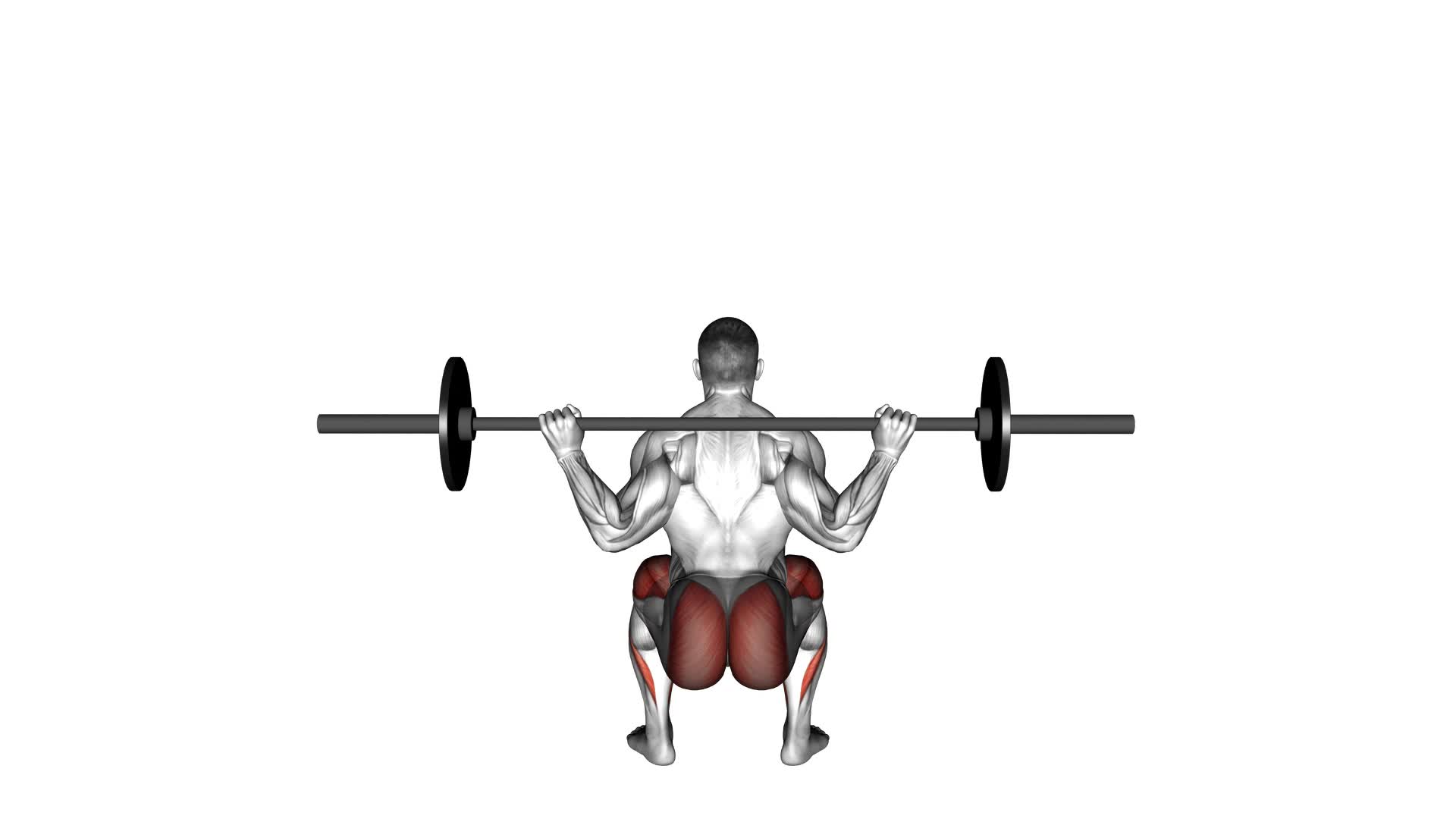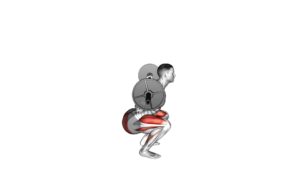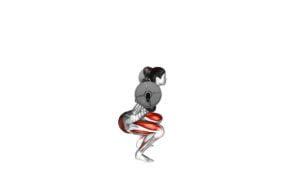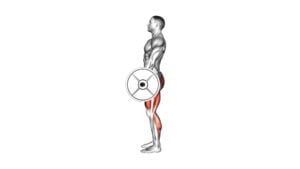Barbell Full Squat (Back POV) – Video Exercise Guide & Tips

Looking to boost your leg strength and build muscle? The Barbell Full Squat is the perfect exercise for you. In this video exercise guide, we'll walk you through the proper form and technique for this challenging move.
Watch This Exercise Video
We'll also share common mistakes to avoid and provide tips for increasing intensity. With our safety precautions, you can confidently master the Barbell Full Squat and take your fitness to the next level.
Let's get started!
Key Takeaways
- The barbell full squat activates multiple muscles in the body and targets the quadriceps, hamstrings, glutes, and core muscles.
- It increases calorie burn, improves muscle definition, and engages smaller stabilizing muscles like calves and lower back.
- The exercise offers versatility with variations and modifications to target specific muscles or accommodate different fitness levels.
- To increase intensity and ensure safety, incorporate progressive overload, vary the depth of the squat, prioritize proper form and technique, and listen to your body while gradually increasing weight and depth over time.
Benefits of the Barbell Full Squat
To experience the benefits of the Barbell Full Squat, start incorporating it into your workout routine today. This exercise is an excellent way to activate multiple muscles in your body and achieve overall strength and stability. When performing the Barbell Full Squat, you engage your quadriceps, hamstrings, glutes, and core muscles. This means that you're targeting large muscle groups, resulting in increased calorie burn and improved muscle definition. In addition to these primary muscle activations, the Barbell Full Squat also engages smaller stabilizing muscles, such as the calves and lower back, further enhancing your overall strength and balance.
One of the great things about the Barbell Full Squat is its versatility. There are various variations and modifications you can incorporate to suit your fitness level and goals. You can adjust the placement of the barbell, such as using a high bar or low bar position, to emphasize different muscle groups. You can also vary the depth of your squat, ranging from parallel to below parallel, to increase or decrease the difficulty level. Additionally, you can incorporate other equipment, such as resistance bands or dumbbells, to add an extra challenge or target specific muscles.
Proper Form and Technique
To perform the Barbell Full Squat with proper form and technique, position the barbell securely on your upper back and shoulders, while keeping your feet shoulder-width apart. This is the starting position for the exercise. As you begin the squat, lower your body by bending at the knees and hips, while keeping your back straight and your chest up. Go down until your thighs are parallel to the ground or slightly below, and then push through your heels to return to the starting position. It's important to maintain control throughout the movement and avoid any bouncing or jerking motions.
There are a few common misconceptions about the Barbell Full Squat that should be addressed. One is the belief that squatting deep is bad for your knees. However, when performed with proper form and technique, squatting deep can actually help strengthen the muscles around the knee joint and improve overall knee stability. Another misconception is that squatting with a wide stance targets the glutes more. While a wider stance may activate the glutes to a greater extent, it also puts more stress on the hips and lower back. It's important to find a stance width that feels comfortable and allows for proper alignment of the knees and hips.
Variations and modifications of the Barbell Full Squat can be used to target specific muscles or accommodate different fitness levels. Some examples include the goblet squat, front squat, and Bulgarian split squat. The goblet squat involves holding a dumbbell or kettlebell at chest level, which can help improve upper body posture and core stability. The front squat places the barbell in front of the body, which requires more core strength and places less stress on the lower back. The Bulgarian split squat is a unilateral exercise that targets the quadriceps and glutes, and can help improve balance and stability. Incorporating these variations and modifications into your training routine can help keep your workouts challenging and prevent boredom.
Common Mistakes to Avoid
Avoid these common mistakes when performing the Barbell Full Squat to ensure proper form and maximize results:
- Incorrect Depth: One of the most common mistakes isn't squatting to the proper depth. Make sure to lower your hips until your thighs are parallel to the ground. Going too shallow can limit the benefits of the exercise, while going too deep can strain your knees.
- Knees Caving In: Keep your knees in line with your toes throughout the movement. Allowing your knees to cave inward can put excessive stress on your joints and increase the risk of injury. Focus on pushing your knees outwards as you squat down.
- Rounding the Back: Maintaining a neutral spine is crucial during the Barbell Full Squat. Avoid rounding your back as it can lead to lower back pain and reduce the effectiveness of the exercise. Keep your chest up, shoulders back, and engage your core.
- Lifting Heels: Keep your feet flat on the ground throughout the entire movement. Lifting your heels shifts the weight forward and can strain your knees. Maintain a stable base by pushing through your heels as you stand back up.
By avoiding these common mistakes and focusing on proper technique, you can perform the Barbell Full Squat safely and effectively.
Now, let's explore some tips for increasing the intensity of this exercise.
Tips for Increasing Intensity
To increase the intensity of the Barbell Full Squat and further challenge your muscles, focus on incorporating these tips into your workout routine.
One effective way to increase intensity is through progressive overload. This means gradually increasing the weight you lift over time. Start with a weight that challenges you but allows you to maintain proper form. Once you can complete your desired number of repetitions with ease, it's time to increase the weight. This progressive increase in weight will stimulate muscle growth and strength development.
Another way to increase intensity is by varying the depth of your squat. By going deeper into the squat, you engage more muscles and increase the difficulty of the exercise. Start by performing squats to parallel, where your thighs are parallel to the ground. As you become more comfortable and stronger, gradually increase the depth by going below parallel. This variation in squat depth will target different muscle fibers and provide a new stimulus for growth.
Remember to always prioritize safety and proper form when increasing intensity. It's important to listen to your body and progress at a pace that's suitable for you.
Safety Precautions for the Barbell Full Squat
Ensure your safety and prevent injuries by following these important precautions when performing the Barbell Full Squat:
- Warm up exercises: Before starting the Barbell Full Squat, it's crucial to properly warm up your body. Engage in dynamic stretches and light cardio exercises to increase blood flow and loosen up your muscles. This will help prepare your body for the intense workout ahead and reduce the risk of strains or pulls.
- Proper footwear: Wearing the right shoes is essential for stability and safety during the Barbell Full Squat. Opt for shoes with a flat and non-slip sole to provide a solid base of support. Avoid shoes with excessive cushioning or a high heel, as they can compromise your balance and form.
- Maintain proper form: It's important to maintain the correct form throughout the exercise. Keep your feet shoulder-width apart, knees in line with your toes, and your back straight. Avoid rounding your back or allowing your knees to cave inward, as this can lead to injury. Engage your core and focus on keeping your weight centered over your heels.
- Start with lighter weights: If you're new to the Barbell Full Squat or haven't performed it in a while, start with lighter weights to allow your body to adapt and build strength gradually. This will help you avoid overloading your muscles and joints, reducing the risk of injury.
Frequently Asked Questions
How Much Weight Should I Start With When Performing the Barbell Full Squat?
When performing the barbell full squat, it's important to start with an appropriate weight that challenges you but doesn't compromise your form. Begin with a weight that you can comfortably lift for 8-12 reps with proper form.
Gradually increase the weight as you become stronger and more confident in your technique. Remember, proper form is key to prevent injuries and maximize results.
Always prioritize safety and listen to your body.
Can the Barbell Full Squat Help Improve My Athletic Performance?
The barbell full squat is a great exercise to improve your athletic performance. It can help you increase explosiveness, which is beneficial for various sports. By incorporating this exercise into your training routine, you can enhance your power and strength.
The barbell full squat targets multiple muscle groups, including your quads, hamstrings, and glutes, making it a versatile and effective exercise for athletes of all kinds.
Is It Necessary to Use a Spotter When Performing the Barbell Full Squat?
When performing the barbell full squat, it's important to consider the necessity of having a spotter. The inclusion of a spotter can provide an extra level of safety and support, especially as you progress in weight.
With a spotter, you can feel more confident pushing your limits and pushing through plateaus. They can assist you in case you struggle with the weight or lose your balance, reducing the risk of injury.
Can the Barbell Full Squat Help Improve My Balance and Stability?
The barbell full squat is a great exercise for improving your balance and stability. By challenging your core and lower body muscles, it helps to strengthen them and increase your overall stability.
Additionally, the squat also requires a good amount of flexibility, which can be improved over time with regular practice. This can help prevent injuries by ensuring that your body is able to move through a full range of motion without any restrictions.
How Often Should I Incorporate the Barbell Full Squat Into My Exercise Routine?
To maximize weightlifting benefits and experience different squat variations, it's recommended to incorporate the barbell full squat into your exercise routine regularly. This exercise targets multiple muscle groups, improving strength and stability.
Aim to perform the barbell full squat at least two to three times a week, allowing enough rest days in between to promote muscle recovery.
Remember to start with lighter weights and gradually increase as you become more comfortable and confident in your form.
Conclusion
In conclusion, the barbell full squat is a highly effective exercise for building strength and muscle in the lower body. By following proper form and technique, avoiding common mistakes, and increasing intensity gradually, you can maximize the benefits of this exercise.
However, it's crucial to prioritize safety by using a spotter, warming up properly, and not lifting too heavy. Incorporating the barbell full squat into your workout routine can lead to significant improvements in strength and overall fitness.

Author
Years ago, the spark of my life’s passion ignited in my mind the moment I stepped into the local gym for the first time. The inaugural bead of perspiration, the initial endeavor, the very first surge of endorphins, and a sense of pride that washed over me post-workout marked the beginning of my deep-seated interest in strength sports, fitness, and sports nutrition. This very curiosity blossomed rapidly into a profound fascination, propelling me to earn a Master’s degree in Physical Education from the Academy of Physical Education in Krakow, followed by a Sports Manager diploma from the Jagiellonian University. My journey of growth led me to gain more specialized qualifications, such as being a certified personal trainer with a focus on sports dietetics, a lifeguard, and an instructor for wellness and corrective gymnastics. Theoretical knowledge paired seamlessly with practical experience, reinforcing my belief that the transformation of individuals under my guidance was also a reflection of my personal growth. This belief holds true even today. Each day, I strive to push the boundaries and explore new realms. These realms gently elevate me to greater heights. The unique combination of passion for my field and the continuous quest for growth fuels my drive to break new ground.







